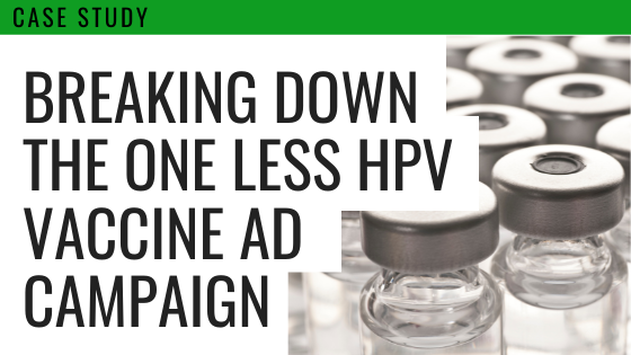O-N-E-L-E-S-S - Breaking Down the One Less HPV Vaccine Ad Campaign with Health Belief Model1/19/2018 One Less HPV Vaccine Ad Campaign
In recognition of Cervical Cancer Awareness Month, let’s talk about HPV and the ad campaign that first introduced the HPV vaccine to the world.
Background
Breakdown
Merck first introduced the Gardasil vaccine with the One Less TV campaign. The campaign focused on empowering women and girls to become one less person with cervical cancer by deciding to get vaccinated. Due to the health behavior change element, Merck’s ad campaign provides a great case study for health communication and marketing.
When planning a behavior change campaign, most public health communicators use a theoretical framework as the foundation for planning, implementation and evaluation. While the marketers behind One Less may not have used a behavioral health theory, retrospectively, this campaign aligns nicely with the Health Belief Model. You can break it down into four aims, targeted to the theoretical constructs of the model: Aim: Establish the threat of cervical cancer
Each construct in the theory and the corresponding aim in the ad were important. Women needed to know that cervical cancer was a relevant threat to them. They also needed to know that there was something they could do about it: getting vaccinated. Additionally, they needed information about getting vaccinated so they could decide if vaccination was for them (or their daughters). And lastly, they needed to feel like they could get vaccinated and successfully prevent cervical cancer. Just as important as the messages, were the women and girls that delivered them. The advertising team behind the campaign was very deliberate in its casting for the ad. They needed the actresses to come off as cool, confident and taking charge of their health. Anyone who didn't fit the bill was cut. And lastly, to leave an impression, the advertising team came up with a catchy, rhythmic slogan: “O-N-E-L-E-S-S, I want to be one less, one less!” Evaluation
Do you think they were successful with this ad campaign?
One study suggests that while the One Less ads were effective in conveying risk information, young women relied primarily on the recommendations of their mothers and medical providers when deciding whether or not to vaccinate. In other words, the information in the ad was not enough. The vaccination messages needed to come from mothers or providers.
This may be why Merck followed up the One Less campaign with the I Chose TV ad campaign, which was aimed more towards parents and included adult women saying, "I chose to get my daughter vaccinated because…” They also made sure to include, “I chose to get my daughter vaccinated because I want her to be one less woman affected by cervical cancer," to tie into the One Less campaign theme.
UPDATE (3/6/20): Temple University's College of Public Health published an interesting article discussing how commercial ad campaigns like O-N-E-L-E-S-S have led to misperceptions about HPV. These campaigns frame HPV as cervical cancer prevention, making HPV seem like a women's health issue. But HPV is a sexual health issue and is a concern for both men and women. HPV can cause other types of cancers, and there are key people at risk for these other cancers, such as gay and bisexual men who are at risk for HPV-related anal cancer, that are unaware of their risk.
References
0 Comments
Your comment will be posted after it is approved.
Leave a Reply. |
�
Learn about our blog submission guidelines. >>
The views and opinions expressed by individual authors on this blog are their own and do not necessarily reflect the official policy or position of Let's Talk Public Health.
Categories
All
|
|
Highlights
Explore
Connect
|
© 2024 Let's Talk Public Health, LLC. All rights reserved. | View our Privacy policy | Terms of service | Disclaimer | Editorial policy.


 RSS Feed
RSS Feed